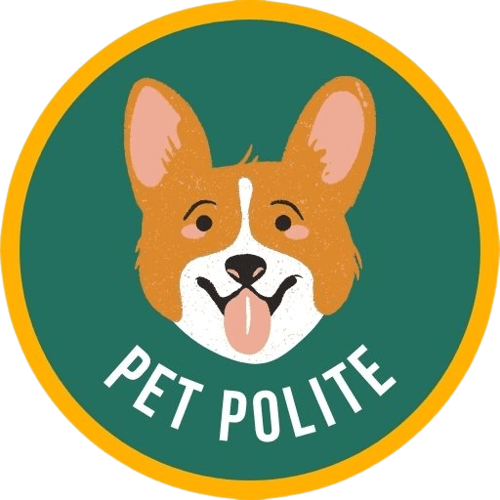When your German Shepherd undergoes surgery, it can be a stressful time for both of you. Your furry friend needs special care to recover fully, and grooming is an important aspect of their hygiene and comfort.
But the problem is that grooming too soon after surgery can put your dog at risk of infection and delay healing.
So, as a concerned pet owner, you may wonder: can I groom my German Shepherd after surgery?
Although grooming your German Shepherd after surgery is possible, it should be done with extra care. Initially, focus on light grooming and daily checks of the surgical site. Gradually increase grooming activities as your dog recovers. Always follow your vet’s recommendations before starting grooming after surgery.
In this article, we’ll cover the best practices and expert tips to keep your dog clean and comfortable during their healing period.
Let’s dive into everything you need to know to care for your German Shepherd after surgery.
Contents
- 1 Things To Keep In Mind For Post-Surgery Grooming
- 1.1 Safe Grooming Techniques For German Shepherds After Surgery
- 1.2 How Often Should You Groom Your German Shepherd After Surgery?
- 1.3 Benefits Of Post-Surgery Grooming For Your German Shepherd
- 1.4 Conclusion
- 1.5 Frequently Asked Questions:
- 1.5.1 Should I groom my German Shepherd after neutering or spaying?
- 1.5.2 How soon after surgery can my German Shepherd get groomed?
- 1.5.3 Can I clean my German Shepherd’s surgical incision?
- 1.5.4 Should I groom my German Shepherd before surgery?
- 1.5.5 Can I bathe my German Shepherd the night before surgery?
- 1.5.6 Does German Shepherd hair grow back after shaving for surgery?
- 1.5.7 Resources Used For Research:
Why It’s Important To Groom Your German Shepherd After Surgery?
Gentle grooming is a powerful tool in supporting your German Shepherd’s recovery and soothe their physical and emotional discomfort after surgery.
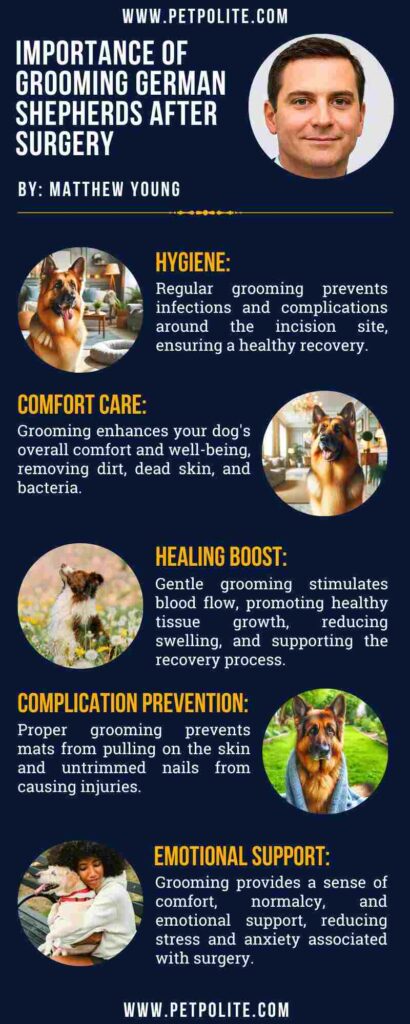
Here’s why it’s important after surgery:
1. Hygiene:
Keeping your German Shepherd clean post-surgery helps prevent infections, especially around the incision site.
Regular grooming removes dirt, dead skin, and bacteria that could otherwise cause complications.
2. Comfort:
Grooming also enhances your dog’s comfort. A clean coat, trimmed nails, and clean ears contribute to their overall well-being, making them feel better during recovery.
3. Healing Boost:
Gentle grooming stimulates blood flow, which is essential for the healing process. Improved circulation helps reduce swelling, promotes healthy tissue growth, and supports the recovery process.
4. Complication Prevention:
Proper grooming can prevent complications such as mats, which can pull on the skin and cause discomfort, and untrimmed nails, which can lead to injuries.
5. Emotional Support:
Grooming provides a sense of comfort and normalcy for your dog, reducing stress and anxiety associated with surgery. This emotional support is helpful for their overall well-being during the recovery period.
Things To Keep In Mind For Post-Surgery Grooming
Grooming your German Shepherd after surgery requires special care and attention to ensure their comfort and promote healing.
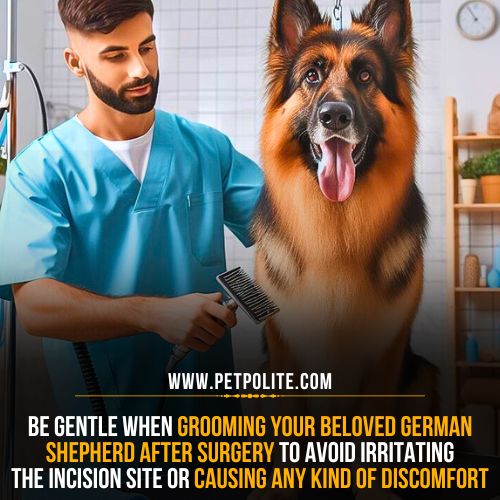
Here are six essential points to consider, explained in detail to help you navigate this process effectively.
1. Timing is Crucial
Post-surgery, your German Shepherd needs time to rest and recover. Avoid grooming in the immediate days after surgery unless absolutely necessary.
Typically, it’s recommended to wait at least 7 days before attempting any form of grooming.
When you do start, keep sessions short and gentle.
Begin with basic tasks like brushing to remove loose fur and gradually reintroduce more involved grooming activities as your dog heals.
2. Avoid the Surgical Site
Avoid brushing, bathing, or applying any products near the area to prevent irritation and infection.
Be vigilant in monitoring the site for signs of complications, such as redness, swelling, or discharge.
Using protective covers or wraps can also help keep the area clean and protected during grooming sessions.

“Wait for vet clearance before bathing your dog, as wet incision sites can lead to infection.”
Source: WagWalking.com
3. Handle Your Dog with Care
Support your dog’s body properly to avoid putting pressure on the surgical area.
Be attentive to their reactions; if your dog shows signs of discomfort, such as flinching or whimpering, stop immediately.
Use slow, soothing movements to keep your dog calm and comfortable. Patience and gentleness will help your dog feel secure and reduce anxiety during grooming sessions.
4. Use Gentle Grooming Tools
Opt for soft, gentle grooming tools to ensure you don’t cause any discomfort or irritation to your recovering dog.
Soft-bristled brushes are ideal for removing loose fur without pulling on the skin.
When bathing is allowed, choose mild, hypoallergenic shampoos free from harsh chemicals and fragrances. These products are less likely to cause allergic reactions or skin irritations.



“Having basic dog grooming supplies at home makes caring for your dog easier and more effective!”
Source: Lucky Puppy Grooming
5. Monitor Your Dog’s Behavior
Post-surgery, your German Shepherd may experience increased grooming anxiety or stress.
Watch for signs of anxiety, such as panting, whining, or restlessness.
Implement calming techniques like speaking softly, gentle petting, and offering treats to create a positive and reassuring environment.
If necessary, use calming aids such as anxiety wraps or pheromone sprays to help soothe your dog.
Safe Grooming Techniques For German Shepherds After Surgery
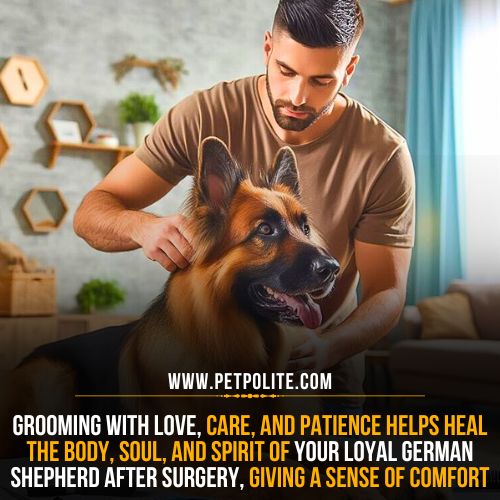

1. Clean the Surgical Wound:
Use a pair of gloves, a cleaning solution (such as saline or sterile water), gauze pads, and a clean towel.
Put on gloves to prevent bacteria from your hands from entering the wound.
Gently remove the old dressing or bandage from the wound, and dip a gauze pad in the cleaning solution.
Wring out the gauze pad thoroughly, then gently wipe the wound from the center outward.
Avoid using harsh scrubbing motions or rubbing too hard.
Pat the wound dry with a clean towel, and apply a new dressing or bandage.
2. Brush Your German Shepherd Carefully:
Start by gently brushing your dog’s coat with a soft brush. Brush in the direction of hair growth to avoid pulling the skin.
Be gentle around sensitive areas like the belly and sides. If you encounter any mats or tangles, use a detangling spray and gently work through them with your fingers or a comb.
Keep sessions short to prevent your dog from getting tired or stressed. Reward your dog with treats and praise for staying calm.
3. Bath Your German Shepherd Gently:
Wait until your vet gives the green light for a bath. When it’s safe, use lukewarm water and a pet-safe shampoo.
Wet your dog’s coat thoroughly, avoiding the surgical site. Apply shampoo and gently massage it into the coat. Rinse thoroughly to remove all soap.
Use a towel to pat your dog dry. If your dog tolerates it, use a blow dryer on a low, cool setting to dry their coat completely.
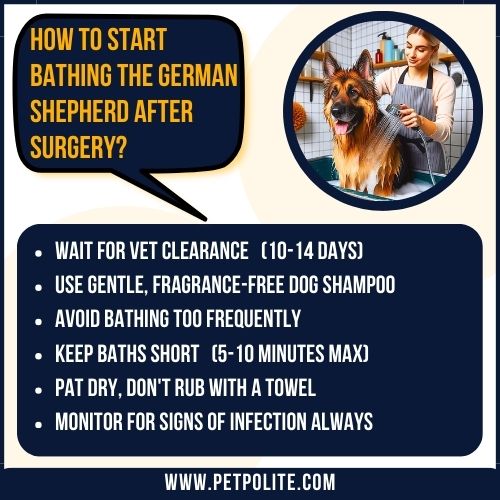

4. Trim Nails (If Needed):
Check your dog’s nails and trim them if needed. Use nail clippers designed for dogs.
Be careful not to cut too close to the quick, which can cause bleeding and pain. If you’re unsure, ask your vet for a demonstration.
5. Clean their Ears:
Use a vet-approved ear cleaner to clean your dog’s ears. Apply the cleaner to a cotton ball and gently wipe the inside of the ear flap.
Do not insert anything into the ear canal. If you notice any discharge or foul odor, contact your vet.
6. Clean Eyes with Care:
Start by gently lifting your German Shepherd’s eyelid and examining the eye.
Use a damp cloth or cotton ball to wipe away any dirt, debris, or discharge gently.
Avoid touching the eye itself, as this can cause discomfort or pain.
Gently wipe the outer eye, removing any dirt or debris.
Use a gentle touch and avoid causing discomfort or pain.
Here’s a video guide to help you groom your dog after surgery.
How Often Should You Groom Your German Shepherd After Surgery?
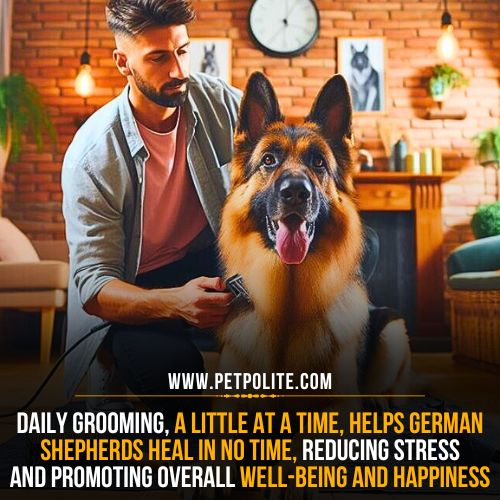

After your German Shepherd undergoes surgery, it’s crucial to adjust their grooming routine to aid in their recovery.
In the immediate post-surgery period, focus on gentle care. Perform daily checks of the surgical site to monitor for any signs of redness, swelling, or discharge. If approved by your vet, lightly clean around the surgical area with a damp cloth.
During the first week after surgery, maintain a cautious approach to grooming. Brush your dog’s coat every 2-3 days using a soft brush, being careful to avoid the surgery area.
Around two to three weeks after surgery, you can gradually increase the frequency of grooming. Begin brushing their coat 3-4 times a week, consider bathing, and continue to trim his nails regularly.
After a month has passed since the surgery, you can typically return to a full grooming routine. Resume brushing, bathing, and ear and eye cleaning as usual.
Here’s a timeline on how to gradually resume your German Shepherd’s grooming routine after surgery:
| Grooming Phase | Description |
|---|---|
| Immediate Post-Surgery Care | Perform gentle daily checks of the surgical site. – Clean around the surgical area if approved by your vet. |
| First Week After Surgery | Brush your dog’s coat after every 2-3 days with a soft brush. – Avoid the surgery area during grooming. |
| Two to Three Weeks After Surgery | Start brushing 3-4 times a week to prevent mats and tangles. – Consider bathing if approved by your vet. – Continue regular nail trimming. |
| One Month and Beyond | Resume full grooming routine, including brushing, bathing, and ear cleaning |
Benefits Of Post-Surgery Grooming For Your German Shepherd
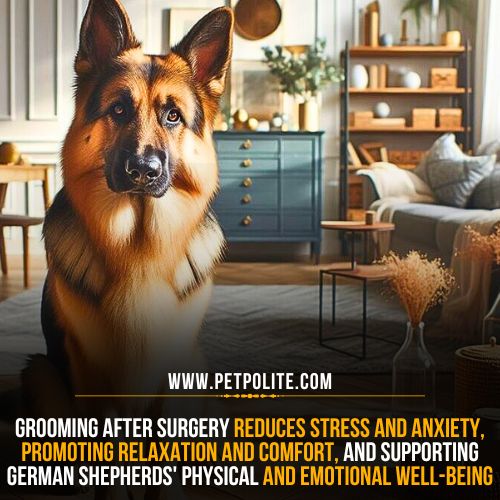

1. Reduces Stress and Anxiety
Gentle grooming can calm your dog, reducing surgery-related stress and anxiety, and leading to a smoother and more comfortable recovery.
2. Prevents Complications
Regular grooming helps identify potential complications, such as infection or wound opening, early on.
This helps you get quick vet care, preventing more severe problems from happening.
3. Supports Pain Management
Grooming can help distract your dog from pain and discomfort, making them more comfortable during the recovery process.
It helps reduce the need for pain medication and promotes a faster recovery.
4. Maintains Hygiene
Grooming helps keep your dog’s ears, eyes, and teeth clean, preventing infections and promoting overall hygiene.
This is especially important during recovery, as infections can be more challenging to treat.
5. Boosts Circulation
Gentle grooming, such as brushing or massaging, can help improve blood flow and circulation, which promotes healthy healing and can reduce swelling and bruising.
Conclusion
Grooming your German Shepherd after surgery requires extra care and attention.
By following your vet’s advice and using gentle techniques, you can ensure your dog stays safe, clean, and comfortable while they recover.
Remember to be patient and make grooming a positive experience for your furry friend.
With the right approach, you can help your German Shepherd heal and feel their best.
Frequently Asked Questions:
Should I groom my German Shepherd after neutering or spaying?
Yes, gentle grooming can help reduce stress and anxiety after neutering or spaying, but wait for vet clearance and follow specific guidelines to avoid complications.
How soon after surgery can my German Shepherd get groomed?
Your German Shepherd can be groomed 7-10 days after surgery, or as cleared by your veterinarian. This allows the incision site to heal and reduces the risk of infection or complications.
Can I clean my German Shepherd’s surgical incision?
Yes, you can clean your German Shepherd’s surgical incision following your vet’s instructions. Use a mild antiseptic solution and gently dab the area with a clean cloth. If you notice signs of infection, contact your vet promptly for guidance.
Should I groom my German Shepherd before surgery?
Yes, it’s recommended to groom your German Shepherd before surgery to remove any mats, tangles, or debris from their coat. This helps reduce the risk of infection and makes it easier for the surgical team to prepare the skin for surgery.
Can I bathe my German Shepherd the night before surgery?
No, it’s not recommended to bathe your German Shepherd the night before surgery. Bathing can introduce moisture to the skin, increasing the risk of infection during surgery.
Does German Shepherd hair grow back after shaving for surgery?
Yes, German Shepherd hair typically grows back after shaving for surgery. The rate of regrowth may vary, but most dogs regrow their fur within 2-3 months.
Resources Used For Research:
- Dog Groomer’s Manual: A Definitive Guide to the Science, Practice and Art of Dog Grooming: A Book by Sue Gould
- German Shepherds: A Practical Guide for Owners and Breeders – A Book by Allison Clarke and Lizzy Brown
- Grooming Manual for the Dog and Cat: By Sue Dallas, Diana North, Joanne Angus
- How To Care For Your Dog After Surgery – PDSA
